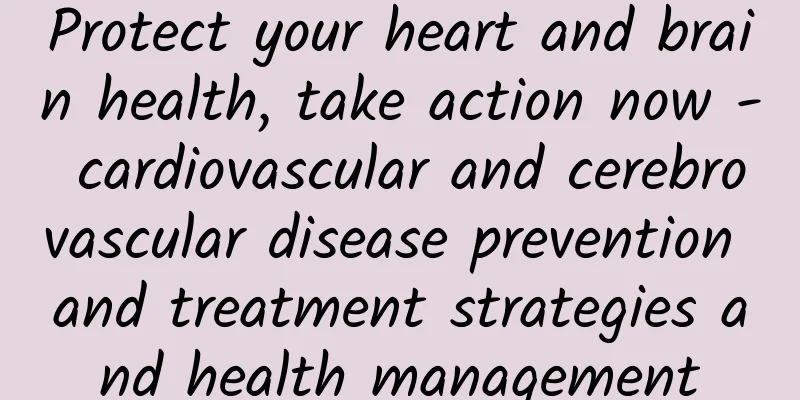Protect your heart and brain health, take action now - cardiovascular and cerebrovascular disease prevention and treatment strategies and health management

|
Cardiovascular and cerebrovascular diseases are one of the major public health problems in the world. Their high incidence and mortality rates have brought huge burdens to society and families. my country is no exception. With the aging of the population and changes in lifestyle, the incidence of cardiovascular and cerebrovascular diseases is on the rise. To meet this challenge, my country has launched the "Healthy China Action", of which the prevention and treatment of cardiovascular and cerebrovascular diseases has become an important part. This article will comprehensively explore how to effectively prevent and treat cardiovascular and cerebrovascular diseases from the aspects of scientific prevention and treatment strategies, health management models and correct health knowledge. The picture comes from the Internet 1. Major risk factors for cardiovascular and cerebrovascular diseases The occurrence of cardiovascular and cerebrovascular diseases is the result of the combined effects of multiple factors. The main risk factors include: 1. Hypertension: Hypertension is one of the main risk factors that can lead to arteriosclerosis, heart disease and stroke. 2. Hyperlipidemia: Hyperlipidemia, especially high levels of low-density lipoprotein cholesterol (LDL-C), can promote the formation of atherosclerosis. 3. Diabetes: Long-term high blood sugar levels in diabetic patients can damage the vascular endothelium and increase the risk of arteriosclerosis. 4. Smoking: Smoking can damage the vascular endothelium and increase the risk of arteriosclerosis. 5. Unhealthy diet: A diet high in salt, fat, and sugar increases the risk of cardiovascular and cerebrovascular diseases. 6. Lack of exercise: Lack of exercise leads to an increased risk of obesity, high blood pressure, diabetes, etc. 7. Obesity: Obesity increases the risk of metabolic diseases such as hypertension, hyperlipidemia, and diabetes. 8. Genetic factors: Family history is an important risk factor for cardiovascular and cerebrovascular diseases. To help everyone better understand the importance of these risk factors, let’s take a look at Lao Wang’s story. Case: Lao Wang’s Story Lao Wang is 55 years old and is a sales manager of a company. Over the years, Lao Wang has been busy with work and has irregular living habits. He often works overtime and stays up late. He prefers greasy and spicy food. In addition, he has many social events and is always smoking and drinking. A few months ago, Lao Wang suddenly felt chest tightness, shortness of breath, and dizziness. Later, at the insistence of his family, he went to the hospital for a check-up. The results showed that his blood pressure was as high as 180/110 mmHg, and his blood lipids and blood sugar were also seriously exceeded. The doctor diagnosed him with hypertension, high blood lipids and diabetes, and told him that if he did not control it, he would face serious risks of cardiovascular and cerebrovascular diseases.
2. Prevention and treatment strategies for cardiovascular and cerebrovascular diseases In order to prevent cases like Lao Wang from happening again, we need to adopt the following specific and feasible health strategies: 1. Healthy eating strategies Reduce salt intake: Keep your daily salt intake to less than 6 grams and avoid high-salt foods. Try using herbs and spices to add flavor to your food instead of salt. Choose healthy fats: Avoid trans fats and saturated fats, and consume more unsaturated fats. It is recommended to use vegetable oils such as olive oil and rapeseed oil instead of animal oils. Increase dietary fiber intake: Eat more whole grain foods, such as whole wheat bread, brown rice, oatmeal, etc., and consume enough fruits and vegetables every day, such as apples, bananas, spinach and broccoli. Control sugar intake: Reduce sugary drinks and sweets, and choose natural foods, such as fruits, instead of processed foods. 2. Strategies for quitting smoking and limiting alcohol consumption Quit smoking: Develop a quit plan, set a clear quit date, and gradually reduce tobacco use. Seek support, participate in quitting smoking counseling and support groups, and use quitting smoking medications and quitting smoking aids, such as nicotine patches, quitting gum, etc. Limit alcohol consumption: Control your drinking amount. Men should not drink more than 25 grams of alcohol per day, and women should not drink more than 15 grams, which is equivalent to 1-2 glasses of wine. Choose low-alcohol beverages, such as low-alcohol beer, non-alcoholic beverages, etc., to reduce the burden on the body. 3. Regular exercise strategy Set exercise goals: At least 150 minutes of moderate-intensity aerobic exercise per week, such as brisk walking, swimming, cycling, etc., or 75 minutes of high-intensity exercise. Walk at least 6,000 steps a day. You can use a pedometer or mobile phone APP to record the number of steps and gradually increase the amount of exercise. The picture comes from the Internet Diversify your exercise methods: Combine strength training with doing strength training twice a week, such as weightlifting, push-ups, sit-ups, etc., to help strengthen muscle and bone health. Increase your daily activities, such as walking to and from get off work, using stairs instead of elevators, doing housework, etc., to increase exercise opportunities in your daily life. 4. Weight management strategies Calculate and monitor body mass index (BMI): Keep BMI between 18.5-24.9, weigh yourself regularly, record weight changes, and adjust your diet and exercise plans in a timely manner. Set a reasonable weight loss goal: lose 0.5-1 kg per week, lose weight gradually through a proper diet and increased exercise, and avoid the health risks of rapid weight loss. 5. Regular physical examination strategy Regularly monitor key health indicators: Conduct a comprehensive physical examination every year, including testing of key indicators such as blood pressure, blood lipids, and blood sugar. High-risk groups should be examined every six months. Establish a personal health record: record the results of each physical examination, including changes in blood pressure, blood lipids, blood sugar and other indicators, to facilitate doctors' diagnosis and treatment plans. The picture comes from the Internet 6. Mental Health Strategies Learn stress-relief techniques: Practicing relaxation techniques, such as deep breathing, meditation, and yoga, can help relieve stress and improve your mood. Maintain good living habits: maintain a regular schedule and ensure adequate sleep. Seek psychological support: Communicate with friends and family, share your emotions and confusion, and seek their understanding and support. If necessary, participate in psychological counseling and receive psychological counseling and treatment. 7. First aid knowledge strategy Learn cardiovascular first aid knowledge: Understand the early symptoms of heart attack and stroke, such as chest pain, shortness of breath, sudden limb weakness or numbness, etc. Master first aid skills, such as cardiopulmonary resuscitation (CPR) and how to use an automated external defibrillator (AED). Participate in first aid training regularly: participate in first aid training courses organized by the community or hospital to improve your self-rescue and other-rescue capabilities. III. Health management model for cardiovascular and cerebrovascular diseases 1. Personalized treatment According to the specific situation of the patient, develop a personalized treatment plan, including drug therapy, lifestyle intervention, etc. Drug therapy should follow the doctor's advice, and regularly review the drug effects and side effects. 2. Long-term management The management of cardiovascular and cerebrovascular diseases is a long-term process that requires close cooperation between patients and doctors, regular review and adjustment of treatment plans. Patients should establish awareness of long-term health management and actively participate in self-management. 3. Patient education Strengthen health education for patients and their families, popularize knowledge on prevention and treatment of cardiovascular and cerebrovascular diseases, and improve patients' self-management ability. Education is carried out through health lectures, popular science articles, community activities and other forms. The picture comes from the Internet 4. Social support Establish and improve the community health management system, and provide comprehensive support services such as psychological counseling, exercise guidance, and healthy diet. The community should regularly carry out health promotion and free clinic activities to improve residents' health awareness. 4. Correct health knowledge about cardiovascular and cerebrovascular diseases In order for the public to better understand and adopt these health strategies, we need to share some correct health knowledge. 1. Hypertension management Hypertensive patients should monitor their blood pressure regularly, take medication as directed by their doctor, and avoid self-adjusting medication dosages. In daily life, they should pay attention to eating a light diet, reducing salt intake, and avoiding overwork and mood swings. 2. Hyperlipidemia management Patients with hyperlipidemia should check their blood lipid levels regularly and take medication as directed by their doctor. They should reduce their intake of high-fat foods and eat more foods rich in unsaturated fats, such as fish and nuts. Moderate exercise can help lower blood lipid levels. 3. Diabetes management Diabetic patients should monitor their blood sugar regularly and take medication as directed by their doctor. They should control their sugar intake and eat more foods with a low glycemic index, such as whole grains and vegetables. Moderate exercise can help control blood sugar. 4. Mental health management Maintaining a good mental state is essential for heart and brain health. You should actively deal with stress and find a decompression method that suits you, such as exercise, reading, listening to music, etc. Avoid long-term anxiety and depression, and seek professional psychological help when necessary. 5. First aid knowledge Learn the first aid knowledge of cardiovascular and cerebrovascular diseases, and promptly identify the symptoms of heart attack and stroke, such as chest pain, shortness of breath, sudden limb weakness or numbness, etc. In case of emergency, call the emergency number immediately to strive for golden rescue time. V. Innovative measures for the prevention and treatment of cardiovascular and cerebrovascular diseases 1. Health Big Data Application Using health big data technology, we will establish a cardiovascular and cerebrovascular disease prevention and treatment database, conduct big data analysis and risk prediction, monitor patients' health indicators in real time through smartphones and wearable devices, and provide personalized health management suggestions. The picture comes from the Internet 2. Telemedicine The development of telemedicine technology has provided a new way to manage cardiovascular and cerebrovascular diseases. Through remote consultation and online consultation, patients can easily obtain guidance and advice from professional doctors and adjust treatment plans in a timely manner. 3. Health education platform Establish an online health education platform to provide rich health knowledge resources and interactive communication platforms. Improve the public's awareness and understanding of cardiovascular and cerebrovascular disease prevention and treatment through online courses, popular science articles, video lectures, etc. 4. Community health services Strengthen the construction of community health service system and provide comprehensive health management services. Community health service centers should regularly carry out health examinations, health lectures, health consultations and other activities to enhance residents' health awareness and self-management ability. 5. Health management apps Develop health management APP and provide personalized health management services. Users can record and monitor their health indicators through APP and get professional health advice and reminders. APP can also provide online consultation, drug reminders, health information and other functions to facilitate users to manage themselves. The picture comes from the Internet Through scientific prevention and health management, we can effectively reduce the incidence of cardiovascular and cerebrovascular diseases, improve the quality of life of patients, and protect the health of the heart and brain. Everyone should take positive actions, start from daily life, develop a healthy lifestyle, and work together to contribute to the goal of achieving a "Healthy China". |
>>: Can drinking a glass of ice water after exercising in hot weather put your life in danger?
Recommend
Presbyopia suddenly disappears? Ophthalmologist: Be careful!
In fact, everyone will suffer from presbyopia, be...
How to relieve abdominal bloating during menstruation
As we all know, in fact, most women often experie...
How to calculate the safe period for women
With the development of modern social economy and...
What does it mean when a girl's lips turn pale?
Girls are particularly concerned about their imag...
In January 2025, Huawei's mobile phone activation volume was 6.3481 million units, ranking first in China. Xiaomi grew 42.49% year-on-year.
Recently, according to media reports, a third-par...
Is bleeding in early pregnancy a boy?
Bleeding in early pregnancy needs to be taken ser...
What should I eat if my vaginal discharge is yellow?
Abnormal vaginal discharge is very common, and it...
No uterus or ovaries
The uterus and ovaries are two essential reproduc...
Nipple pain is a symptom of pregnancy
Pregnancy is a happy thing for most people, but s...
What are the auxiliary measures for the treatment of skin vitiligo?
Nowadays, there are still many people suffering f...
White spots on nails are not caused by calcium deficiency! The nails that really need to be worried are like this...
We give so much meaning to our nails! "My na...
Are the zero-monthly-rent data cards sold online IoT cards? What are the risks of using IoT cards?
Many friends have heard that there is a kind of z...
Causes of Excessive Vaginal Discharge
Excessive vaginal secretions are a disease that t...
What kind of milk powder is good for mid-pregnancy
Many women drink milk powder during pregnancy. Th...
How to treat female breast hyperplasia?
Breast hyperplasia is a very common gynecological...









